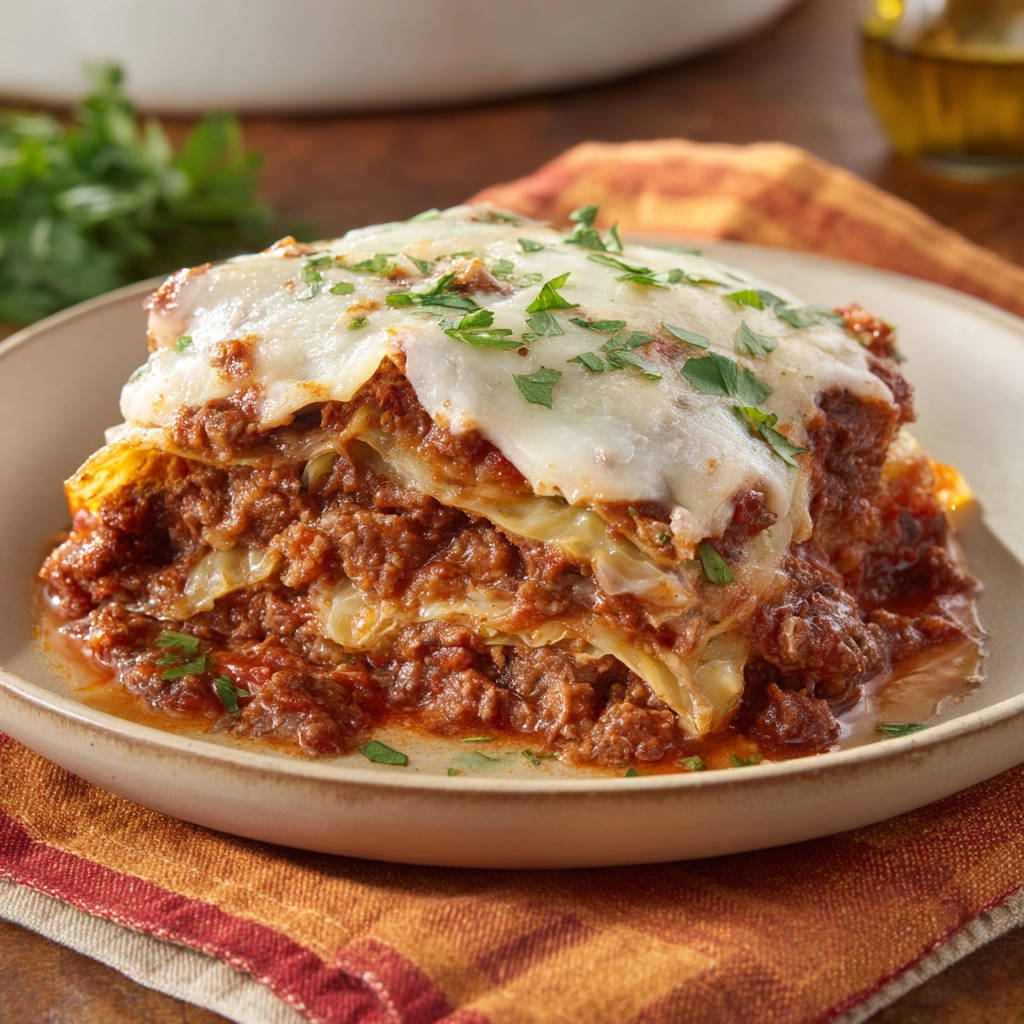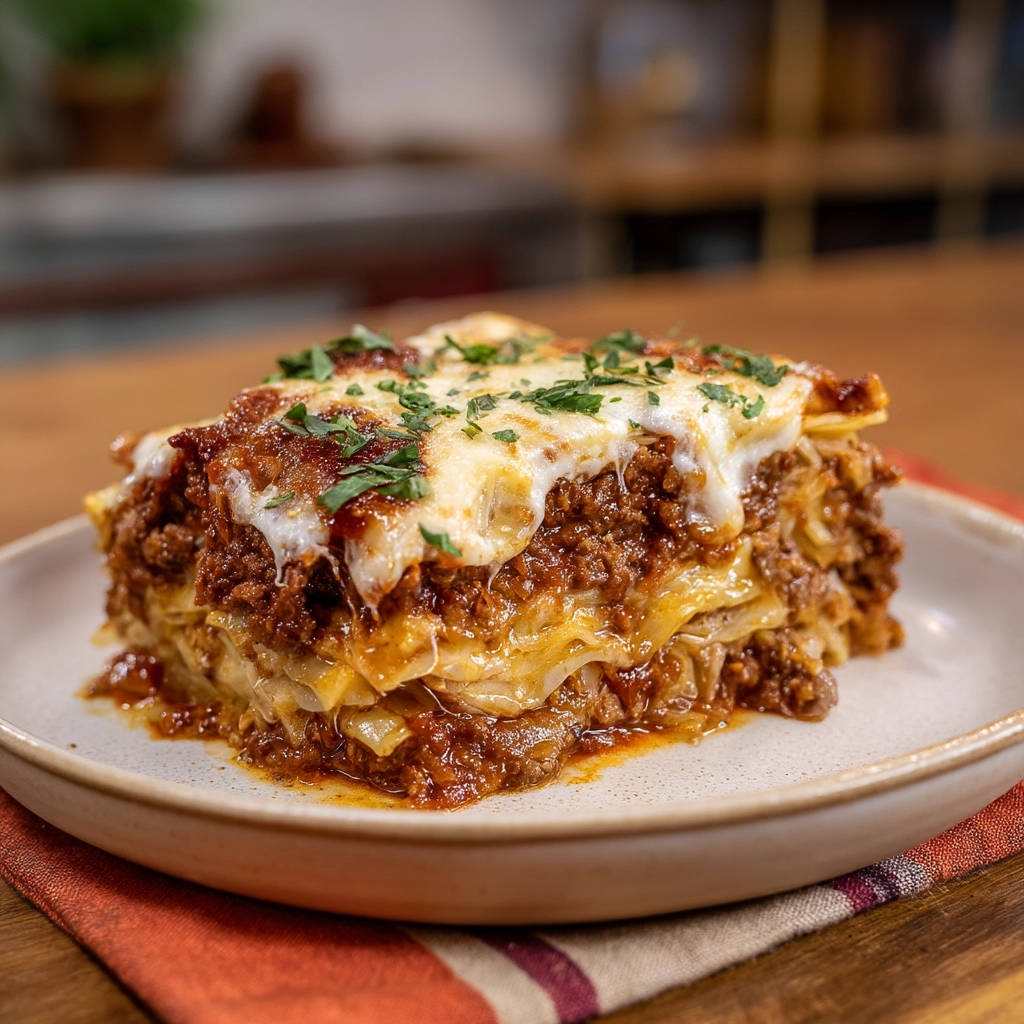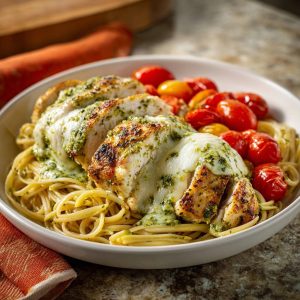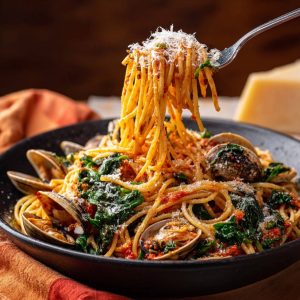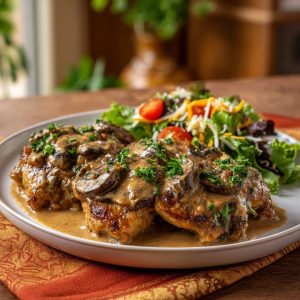Hey there, fellow food lovers! Have you ever spent time layering up what you think is going to be a glorious, hearty lasagna, only to serve it and find a watery puddle lurking at the bottom? It’s such a disappointment, isn’t it? This used to happen to me constantly, especially when I started experimenting with alternatives to traditional pasta sheets – like cabbage! Cabbage is fantastic for adding a healthy, low-carb twist, but it holds a lot of moisture. For the longest time, I couldn’t figure out how to prevent that dreaded soggy base in my cabbage lasagna bake.
But after much trial and error, I finally cracked the code on creating a perfectly structured, flavorful, and blissfully dry-bottomed cabbage lasagna bake. There’s one simple, crucial step that makes all the difference, and I can’t wait to share it with you. Get ready to enjoy all the comforting layers you love, without the watery surprise!
Reasons This Cabbage Lasagna Bake is a Keeper
Beyond solving the soggy bottom problem, there are so many reasons why this particular cabbage lasagna bake recipe is a winner:
- It’s a fantastic way to enjoy classic lasagna flavors while significantly reducing carbohydrates.
- It’s surprisingly filling and satisfying, packed with rich meat sauce and melty cheese.
- The “secret” technique ensures beautiful, firm layers every single time.
- It’s perfect for meal prep and reheats wonderfully (again, without becoming a watery mess!).
- It’s a family-friendly dish that’s hearty enough for a weeknight dinner or weekend gathering.
Gathering Your Ingredients for Cabbage Lasagna Bake
To create this comforting Cabbage Lasagna Bake, you’ll need a combination of fresh produce, savory meat, a rich tomato base, and, of course, plenty of cheese. Each component plays an important role in building flavor and structure.
Let’s start with the star ingredient, the cabbage. You’ll need 1 head of green cabbage. Look for a head that feels heavy for its size and has tightly packed leaves. The fresh cabbage leaves will replace the pasta sheets, providing a tender bite and a touch of earthy sweetness once cooked.
For the foundation of our savory meat sauce, we begin with a little fat for sautéing and building flavor. You’ll need 1 tablespoon of olive oil. This helps soften our aromatics and brown the meat beautifully.
The heartiness of this bake comes from the protein. We use 1 pound of ground beef. I usually opt for a lean ground beef (like 85-90%) to reduce excess grease, but any kind will work – just be sure to drain off the fat properly.
Flavor builders are next! Aromatic vegetables are key to a good sauce. Grab 1 medium onion, finely chopped, and 2 cloves of garlic, minced. These cook down to create a sweet and pungent base for the meat and tomatoes.
Our rich, bubbly sauce relies on tomatoes. You’ll need a large can, specifically 28 ounces of crushed tomatoes. Crushed tomatoes provide a thicker texture than diced, which is beneficial for a bake like this, helping the sauce cling to the layers and contribute to the overall structure.
Herbs and spices elevate the simple tomato and meat base into something truly comforting and Italian-inspired. Measure out 1 teaspoon of dried oregano and 1 teaspoon of dried basil. These classic herbs bring that familiar, comforting flavor. We’ll also season with 1/2 teaspoon of salt and 1/4 teaspoon of black pepper. Remember you can adjust these to your taste later!
And what’s lasagna without cheese? A generous amount of melted cheese holds everything together and adds a lovely creamy, salty contrast to the savory filling and tender cabbage. You’ll need 2 cups of shredded mozzarella cheese. Freshly shredded mozzarella often melts more smoothly than pre-shredded.
Finally, for a pop of color and fresh flavor right before serving, have some fresh parsley, chopped for garnish, ready. It adds a bright finish to the rich dish.
Crafting Your Cabbage Lasagna Bake: Step-by-Step
Putting together this cabbage lasagna bake is straightforward, but paying close attention to the key technique for the cabbage is what will elevate your results from potentially watery to perfectly layered and delicious. Let’s walk through each step:
-
Prepare the Cabbage Layers: Begin by preparing your cabbage leaves. Bring a large pot of well-salted water to a rolling boil. While the water heats, carefully core the head of cabbage at the base. Once cored, you can often peel off the outer leaves one by one. Be gentle so they don’t tear. For any leaves where the thickest part of the stem runs through the center, use a knife to carefully trim away that tough section without splitting the leaf entirely. This makes the leaves lie flatter and softens the tougher part. Immerse the separated cabbage leaves in the boiling water for just 2 to 3 minutes. You want them to soften slightly so they are pliable and easy to work with, but not so much that they become mushy. They’ll continue to cook in the oven.
-
The Absolutely Essential Drying Step: This is the secret weapon against watery lasagna! As soon as you remove the blanched cabbage leaves from the boiling water (tongs work great here), lay them out flat in a single layer on paper towels or clean kitchen towels. Immediately place another layer of paper towels or towels on top. Use your hands to gently but firmly press down on the leaves. You’ll be amazed at how much excess water comes out! This step is crucial because cabbage releases a lot of moisture as it cooks. By pressing out as much as possible now, you prevent it from pooling in your baking dish later. Set the dried leaves aside while you make the sauce.
-
Build the Flavorful Meat Sauce: Heat your tablespoon of olive oil in a large skillet or pot over medium heat. Add the finely chopped onion and cook, stirring occasionally, until the onion softens and turns translucent, which usually takes about 5 minutes. Next, add the pound of ground beef to the pan. Use a spoon or spatula to break up the beef into small crumbles as it cooks. Continue to cook until the beef is fully browned. Once browned, carefully drain off any excess grease from the pan. This also helps prevent your final dish from being greasy.
-
Simmering the Sauce: Once the beef is browned and drained, stir in the minced garlic, dried oregano, dried basil, salt, and black pepper. Cook for just about 1 minute, stirring constantly, until you can really smell the fragrant herbs and garlic. This quick toast helps release their flavors. Pour in the 28 ounces of crushed tomatoes. Stir everything together to combine. Bring the sauce to a gentle simmer, then reduce the heat to low. Let the sauce simmer uncovered for 15 to 20 minutes. Stir it occasionally. Simmering allows the flavors to meld and, importantly, helps the sauce thicken slightly, which also aids in preventing a watery bake. A slightly thicker sauce is less likely to release excess liquid into the layers.
-
Prepare for Assembly: While the sauce is simmering, preheat your oven to 375 degrees Fahrenheit (190 degrees Celsius). Have your 9×13 inch baking dish ready. Spoon a thin, even layer of the finished meat sauce into the very bottom of the dish. This layer helps prevent the bottom layer of cabbage from sticking and provides flavor.
-
Begin Layering with Cabbage: Now, start arranging your prepared and dried cabbage leaves over the thin layer of sauce. Overlap the leaves slightly as needed to create a continuous layer that covers the bottom of the dish. Don’t worry if the pieces aren’t perfectly uniform; just aim for good coverage. Trim pieces if necessary to fit the dish.
-
Add Sauce and Cheese: Spoon about one-third of the remaining meat sauce evenly over the cabbage layer. Spread it out gently so it covers the leaves. Then, sprinkle about one-third of the shredded mozzarella cheese over the sauce layer. The cheese will melt and help bind the layers together.
-
Repeat the Layers: You will repeat the cabbage, sauce, and cheese layers two more times. Start with another layer of dried cabbage leaves, then another one-third portion of the meat sauce, followed by another one-third of the shredded mozzarella cheese. Finish with the last layer of cabbage, the remaining meat sauce, and finally, top generously with the rest of the mozzarella cheese. You want that beautiful cheesy crust on top!
-
Bake to Golden Perfection: Place the assembled cabbage lasagna bake in your preheated oven. Bake for 25 to 30 minutes. You’ll know it’s ready when the cheese on top is melted and bubbly, and the sauce around the edges is hot and perhaps gently bubbling. The house will smell amazing!
-
Rest Before Serving: This step is just as important as drying the cabbage! Once the lasagna comes out of the oven, let it stand undisturbed for 5 to 10 minutes before slicing and serving. This resting time allows the layers to settle and the sauce to firm up slightly, making it much easier to cut neat portions and further preventing any potential liquid from spreading. Just before serving, sprinkle with fresh chopped parsley for a burst of color and freshness. Enjoy your perfectly layered, non-watery cabbage lasagna bake!
Tips for Perfect Cabbage Lasagna Bake Every Time
While the drying trick is the main event, a few other pointers can help ensure your cabbage lasagna bake is a resounding success:
-
Choose the Right Cabbage: A regular green cabbage works best for this recipe. Savoy cabbage can also work, but red cabbage tends to bleed color into the dish. Look for a firm, fresh head.
-
Don’t Skip the Blanching: Blanching isn’t just for softening; it also starts the process of drawing out some moisture and makes the leaves flexible enough to layer easily without tearing.
-
Press, Press, Press!: I cannot stress this enough. Use plenty of paper towels (or reusable cloth towels you don’t mind getting wet) and apply firm pressure. You really want to squeeze out as much water as possible after blanching.
-
Thicken Your Sauce: Simmering the meat sauce for the full 15-20 minutes helps it reduce and thicken. A thicker sauce means less free liquid in the final bake.
-
Drain the Meat Properly: Excess grease from the ground beef can also contribute to a watery or oily lasagna. Be sure to drain it off after browning.
-
Resting is Key: Letting the lasagna rest for 5-10 minutes after baking allows the cheese to set and the layers to firm up. Cutting into it too soon is a sure way to have it fall apart and potentially look looser.
-
Make Ahead: You can assemble the entire lasagna (steps 1-9) ahead of time. Cover it tightly with plastic wrap and foil and refrigerate for up to 24 hours. When ready to bake, let it sit at room temperature for about 30 minutes while your oven preheats, then bake as directed, possibly adding 5-10 minutes to the baking time if it’s still very cold.
-
Freezing Instructions: This cabbage lasagna bake freezes beautifully. You can freeze the assembled, unbaked lasagna (cover tightly) or freeze leftovers. To bake from frozen, remove foil, cover tightly again with new foil, and bake at 375°F (190°C) for about 60-75 minutes, or until heated through. Remove the foil for the last 15-20 minutes to brown the cheese. For leftover portions, let them thaw in the refrigerator then reheat in the oven or microwave.
-
Flavor Boosters: Want to add a little extra depth? Consider adding a pinch of red pepper flakes to the meat sauce for a touch of heat, or a bay leaf while simmering (remember to remove it before layering!). Sometimes, adding a tiny pinch of sugar or a splash of balsamic vinegar to the tomato sauce can balance the acidity and enhance the overall flavor profile, similar to how you might elevate a classic beef ragu.
What to Serve With Your Cabbage Lasagna Bake
This hearty bake is a meal in itself, but a simple side dish can round it out perfectly. A fresh, crisp salad is always a great choice to cut through the richness. Our Easy Kale Salad or a simple green salad with a light vinaigrette would be lovely. Some crusty bread for dipping in the extra sauce (if there is any!) is also a classic pairing. If you’re looking for another veggie side, consider Crispy Roasted Brussels Sprouts for some texture and flavor.
Your Cabbage Lasagna Bake Questions Answered (FAQ)
Let’s tackle some common questions you might have about making this Cabbage Lasagna Bake:
Can I use a different type of meat?
Absolutely! While ground beef is classic, you could easily substitute ground turkey, ground chicken, or a combination of ground meats. Cook and drain them the same way. For a vegetarian version, you could use lentils, mushrooms, or a plant-based ground meat alternative.
Is this Cabbage Lasagna Bake low carb?
Yes, using cabbage leaves instead of pasta dramatically reduces the carbohydrate count compared to traditional lasagna. It’s a popular choice for those following lower-carb eating plans.
Do I have to blanch the cabbage?
While you could try skipping the blanching, it’s highly recommended. Blanching softens the leaves for easier layering and, crucially, makes them more receptive to the drying step which is key for preventing sogginess. Raw cabbage leaves are also much tougher and won’t have the tender, lasagna-like texture.
Can I use other types of cheese?
Mozzarella is excellent for its meltiness and mild flavor, but feel free to experiment. You could add some shredded cheddar, provolone, or a sprinkle of Parmesan cheese between layers or on top for extra flavor. A blend of cheeses can be wonderful!
My cabbage leaves are small, how do I layer them?
Don’t worry if your leaves aren’t perfectly large. You can layer smaller pieces, overlapping them significantly to create a solid “pasta” layer. Just make sure there aren’t large gaps.
How do I know when the lasagna is fully cooked?
The best indicators are the appearance of the cheese (melted and bubbly, potentially golden brown spots) and the sauce (hot and simmering around the edges). You can also gently insert a knife into the center; it should go through easily, indicating the cabbage is tender.
Why is resting the lasagna important?
Resting allows the heat to distribute evenly and the liquids in the sauce and cheese to settle and thicken slightly. This helps the lasagna hold its shape better when you slice into it, preventing it from being a runny mess.
Enjoy Your Homemade Cabbage Lasagna Bake!
There you have it – the simple trick to enjoying a perfectly layered, incredibly satisfying Cabbage Lasagna Bake without the disappointment of a watery mess. This recipe is a testament to how small techniques can make a huge difference in your cooking results. It’s cozy, comforting, and a fantastic way to switch up your dinner routine.
I truly hope you give this recipe a try and discover the magic of properly prepared cabbage layers. When you make it, please come back and let me know how it turned out in the comments below! I love hearing from you and seeing your delicious creations. Happy cooking!
Cabbage Lasagna Bake
Ingredients
- 1 head green cabbage
- 1 tablespoon olive oil
- 1 pound ground beef
- 1 medium onion finely chopped
- 2 cloves garlic minced
- 28 ounces crushed tomatoes
- 1 teaspoon dried oregano
- 1 teaspoon dried basil
- 1/2 teaspoon salt
- 1/4 teaspoon black pepper
- 2 cups shredded mozzarella cheese
- Fresh parsley chopped for garnish
Directions
- Prepare the cabbage: Bring a large pot of salted water to a boil. Core the cabbage and carefully peel off large leaves. You may need to trim the thickest part of the stem from each leaf. Blanch the leaves in boiling water for 2 to 3 minutes until slightly softened but still pliable.
- This is the key step to avoid watery layers: Remove the blanched cabbage leaves and lay them flat on paper towels. Gently press another layer of paper towels on top to absorb as much excess water as possible. Set aside.
- Make the meat sauce: Heat olive oil in a large pan over medium heat. Add the chopped onion and cook until softened, about 5 minutes. Add the ground beef and cook, breaking it up with a spoon, until browned. Drain off any excess grease.
- Stir in the minced garlic, oregano, basil, salt, and pepper. Cook for 1 minute until fragrant. Pour in the crushed tomatoes and bring the sauce to a simmer. Reduce heat to low and let it simmer for 15 to 20 minutes, stirring occasionally, until the sauce has thickened slightly.
- Assemble the lasagna: Preheat oven to 375 degrees Fahrenheit (190 degrees Celsius). Spoon a thin layer of meat sauce into the bottom of a 9×13 inch baking dish.
- Arrange a layer of the drained cabbage leaves over the sauce, overlapping slightly if needed to cover the bottom.
- Spread about one-third of the remaining meat sauce over the cabbage layer.
- Sprinkle about one-third of the mozzarella cheese over the sauce.
- Repeat the layers twice more: cabbage, sauce, cheese.
- Bake the lasagna in the preheated oven for 25 to 30 minutes, or until the cheese is melted and bubbly and the sauce is hot.
- Let the lasagna stand for 5-10 minutes before serving to help it set slightly. Garnish with chopped fresh parsley.

